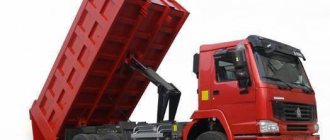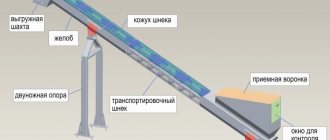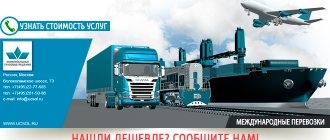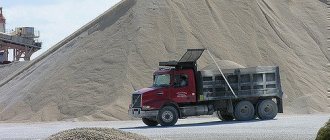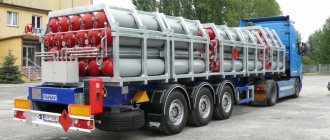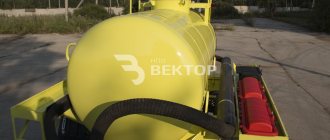Bulk cargo is used primarily in two industries - construction and agriculture. In most cases, prompt delivery to the place of its application is necessary, so all available methods are used: delivery by water, delivery of goods by road and via railway. Transportation of bulk cargo cannot be carried out using various types of transport, but the procedure itself must be carried out according to certain rules, which are directly prescribed in existing regulations.
What are bulk cargoes
Bulk cargo includes substances transported without containers or in large-capacity bags. In turn, bulk materials are divided into bulk and bulk. The first type includes grain and non-grain agricultural cargo. The type of bulk cargo includes other bulk industrial materials, such as coal, sand, crushed stone.
In the photo, transportation of crushed stone by tonars
Freight turnover of bulk substances is carried out using road, sea and air transport. Road transportation is a priority for most, as materials can be delivered even to remote corners of the country and the world. And this despite the high cost of services.
When transporting, it is necessary to take into account the physical, chemical and biological parameters of the substances being transported in order to avoid friction, fire or changes in structure.
The state of aggregation requires close attention. Some types of metal ore, under certain conditions, liquefy or, conversely, become even harder. Such cargo is transported in special closed containers.
Advantages of cooperation with LT Logistic
The transport company LT Logistic will quickly and safely transport bulk cargo throughout the Russian Federation and abroad. We have been transporting a variety of products for many years and know all the nuances that may arise at any stage of delivery. All goods are transported in accordance with all rules and regulations. Therefore, you can be sure that the material will arrive safe and sound within the specified time frame.
Cooperation with us has a number of undeniable advantages:
- high quality service;
- large selection of transport;
- safe movement of special goods;
- 24/7 delivery 24/7/364;
- prompt delivery to any corner of the world;
- affordable prices.
You can order a comprehensive service for the transportation of bulk goods or a separate option, as well as find out the cost, by calling the phone number listed on the website or sending a request through the feedback form.
Basic conditions
The regulations for the transportation of bulk cargo are implemented by section 26 of the “Rules for the transportation of bulk cargo” as amended in 2007. To help this section comes Government Resolution No. 272 of April 15, 2011, which specifies only the basic requirements for the traffic of bulk metal luggage (not agricultural cargo):
- materials are poured only using special equipment. It is imperative to take into account that loading is carried out from a height of at least a meter above the bottom of the vehicle body;
- The driver of the vehicle should not be in the cab during loading. In turn, the excavator worker should not lift and move the equipment bucket over the truck cab;
- the body with the transported material is covered with an awning to avoid particles of cargo getting on the road surface and not causing an accident;
- the loading level is not higher than the top edge of the sides. That is, it is prohibited to pour “heaped” in order to avoid the occurrence of dangerous situations during the journey;
- the shipper is obliged to fence off the roadway for the safe passage of dump trucks, provide haulage trucks in case the loading area is tilted, and spray water to remove dust at the loading area;
- the sequence of the loading process is agreed upon by both parties and recorded in the contract as a separate clause;
- the recipient company is obliged to clean the tractor body after complete unloading;
- control of the volume of loaded substance is required. It is weighed both during loading and unloading to determine losses (shrinkage, leakage, theft);
- cargo does not pass weight control if it does not bring commercial profit, for example, removal of snow or construction waste.
Calculation of the number of vehicles and other preparatory measures
The optimal technology is selected taking into account the volume and parameters of the cargo, distance and other features of the route. Vehicles are universal and suitable for work in quarries and construction sites. It is used for transportation between workshops of industrial enterprises and on international flights.
In a large assortment of models, it is easy to choose an option with a suitable load capacity and body dimensions. The calculation is carried out based on the required delivery schedule. The most difficult thing is to deliver cargo to several recipients with partial unloading.
It is worth checking the requirements of local authorities regarding the transportation route. Often the contractor is faced with additional restrictions (unexpected, as a rule) when working in a region other than his own. In the worst case scenario, you can get a ban on the use of a certain vehicle on a given route, for example, due to exceeding the maximum weight.
The railway is more convenient and profitable over long distances. It performs its functions uninterruptedly in difficult weather conditions. Compliance with a standard schedule allows you to accurately plan economic and commercial activities.
At the next stage, the order executor is determined. It is convenient if the carrier has a large fleet with a variety of equipment. In this case, it is easier to choose a car that exactly matches a specific task. It is acceptable to conclude one-time contracts. However, long-term cooperation is more profitable. Such relations imply not only a democratic pricing policy. Contractors may offer deferred payments and other financial and organizational benefits.
Standard rules for transporting bulk cargo by dump trucks imply the responsibility of the sender to create favorable conditions at the place where the body is filled. It is necessary to establish driveway markings, designate a potentially dangerous area, and prevent access by unauthorized persons.
Loading operations are carried out in accordance with current standards with a stable installation of the excavator and other equipment on the site. Be sure to control the maximum wind loads. Operations are not performed under conditions that could damage the cargo.
Transport for bulk cargo
Any vehicle is not suitable for transporting bulk and bulk materials. For each trip, a specific type of car is selected.
The vehicle must facilitate the process of loading and unloading bulk substances and correspond to the type of cargo:
- Dump trucks. Trucks with a trailer or semi-trailer body type with a hydraulic system for unloading and at least one tailgate. When transporting by dump trucks, it is necessary to pay attention to the reliability of fastening of the awning and the tight fit to the transported substance.
- Container ships. A tractor with a platform on which the container is placed. This type is in demand for long trips. For this type, it is necessary to control the tightness of the seams to prevent cargo leakage.
- Tanks. They are used to transport liquid substances, sometimes bulk cargo is transported in them. Tightness and preservation of climatic conditions inside the tank are important.
Rules for the transportation of diesel fuel in tank trucks.
Rules for the transportation of bulk materials
When choosing a vehicle to transport a crumbly substance, always take into account its physical, chemical properties, volume and size. Any materials that interact with moisture must be transported in a body covered with an awning. Mandatory covering with an awning applies to cargo, the delivery of which involves a route through populated areas. When choosing what to transport bulk materials in, balance the weight of the cargo and the carrying capacity of the vehicle. The sender and recipient of the cargo must provide convenient passage for loading/unloading equipment and transport vehicles.
Transportation rules
In addition to the general conditions from section 26 of the “Rules for the transportation of goods in bulk”, it is worth additionally noting some features, the main one of which is the lack of packaging. Therefore, transporting bulk cargo poses a danger to other traffic participants and the roadway due to possible ingress of particles:
- cargo capacity of transport, which must be at least 6 tons for food cargo, and for others - at least 12 tons;
- prompt development by logisticians of the carrier company of the route in accordance with the requirements;
- uniform placement of the transported substance on the body, not exceeding the level of the sides, and also maintaining the permissible height;
- knowledge and compliance by the driver of the vehicle with the speed limit of the established traffic rules.
Transportation of bulk and bulk materials without appropriate documentation is not permitted. For a smooth trip, the vehicle driver must have the following documents at hand:
- goods - waybill;
- contract for the movement of bulk cargo. Required for transportation by a special organization;
- written confirmations from loading and unloading sites.
A distinctive feature of the traffic of bulk solids is the prohibition on declaring the value of the transported material. This feature is reflected in Resolution No. 272 of April 15, 2011. Instead, sealing the vehicle is now sufficient.
Dangerous goods transportation sign.
Not everyone conscientiously follows the rules for the transportation of bulk materials. Therefore, Article 12.21 of the Code of Administrative Offenses stipulates fines for non-compliance with the rules:
| Violation | Collection |
| Lack of cargo inspection before shipment | Vehicle driver - 500 rubles, official 2 - 5 thousand rubles. , company - up to 300 thousand rubles. |
| Creating a dangerous situation | Driver 5000 - 10000 rub. , official 20 - 25 thousand rubles, legal entity 300 - 400 thousand rubles. |
| Failure to comply with traffic rules | Vehicle driver - 500 rubles, official 2 - 5 thousand rubles. , company - up to 300 thousand rubles. |
Operating procedure
1.
Route planning and cost calculation. Coordination. Preparation of documents.
2.
Preparation of documents. Invoicing.
3.
Cargo collection, weighing, packaging.
4.
Sending cargo to its destination.
5.
Receipt of cargo, transfer of closing documents.
Advantages :
- Large range of automobiles : dump trucks, Kamaz trucks, trucks, etc.
- The ability to monitor cargo , thanks to modern GPS and GLONASS. Upon request, your manager will inform you about the location of the cargo carrier, as well as the condition of the cargo.
- Possibility of insuring the goods - our clients independently determine the need to conclude an appropriate contract, and we will offer the most profitable option so that you do not incur unnecessary expenses.
The company's drivers regularly undergo medical examinations before each trip. We strictly observe established safety standards and adhere to them exactly.
Loss in transit
The carrier is responsible for the quality of the transported cargo, timely delivery, integrity and weight loss.
And such troubles can happen due to:
- violation of the tightness of the body, container or tank. The result is a spilled part of the cargo;
- erosion by wind - part of the volume is blown out;
- incorrectly selected container for the transported material;
- sudden maneuver on the road to prevent an accident;
- theft of part of the cargo.
In addition, we should not forget about natural causes of changes in volume and weight, for example, drying out of cargo, ripening during transportation.
The level of guilt of the carrier is regulated by Article 796 of Federal Law No. 14 of the Civil Code of the Russian Federation.
Characteristics of transported goods
1.6 CHARACTERISTICS OF TRANSPORTED GOODS
Bulk cargo. Bulk cargoes are characterized by such properties as size, density, mobility, coefficient of external friction, abrasiveness, caking, stickiness, freezing. Characteristics of some properties of bulk cargo are given in Table 1.9.
The granulometric composition is characterized by the quantitative distribution of pieces of cargo according to their size. It is determined by sieve analysis, in which a regulated volume of cargo (sample) is sifted sequentially through a set of sieves with calibrated holes of various sizes (numbers).
If a piece in three dimensions has dimensions a, a2, a3, then the average calculated size is:
Properties of bulk cargo
| Table 1.9 Name cargo
| ||||||||||||||||||||||||||||||||||||||||||||||||||||||||||||||||||||||||||||||||||||||||||||||||||||||||||||||||||||||||||||||||||||||||||||||||||||||||||||||||||||||||||||||||
Depending on the ratio of individual fractions, ordinary and sorted cargo are distinguished. If atax and atin are the sizes of the largest and smallest pieces, then for ordinary cargo atax/atin > 2.5, for sorted cargo atax/amin < 2.5.
Bulk cargo is characterized by the size a' of a typical piece - for sorted cargo, the size of a typical piece is taken to be a' = 0.5(atax + atin). For ordinary cargoes, the size a' is determined depending on the ratio of the mass m0 of the cargo of the largest pieces to the mass m of the entire sample (c = m0/t). When c > OD, a' = amax; at c < 0.1, a' = 0.8 atach.
The classification of bulk cargo by size is presented in Table 1.10.
Density is the ratio of the mass of a load to its occupied volume. A distinction is made between the density of loosely poured cargo and dynamically compacted cargo. The compaction of cargo is characterized by the compaction coefficient ku = ru / p; for most bulk cargo k = 1.1...1.3.
Based on density, bulk cargo is classified as light - with a density of less than p < 0.6 t/m3; average - 0.6 < p < 1.1 t/m3; heavy - 1.2 < p < 2.0 t/m3; very heavy - more than p > 2.0 t/m3. The density of bulk cargo is given in Table 1.9.
| Table 1.10 Classification of bulk cargo by size Name cargo
|
External friction coefficient f
characterizes the resistance to the movement of bulk cargo relative to the surfaces of solid bodies, caused by friction.
A distinction is made between the coefficient of friction at rest f ∂
and during relative movement of the load
f
Their ratio can be taken f
∂ ≈
0.7…0.9) f
.
The values of the coefficients of external friction at rest for rubber and steel are given in Table 1.9.
The mobility of bulk cargo is determined by the angle of repose at rest, i.e. the angle of inclination of the generatrix of the freely poured load to the horizontal plane f. Based on the mobility of particles, bulk cargoes are divided into: well-flowing, the angle of repose of which is f < 30...350; average flowability 35° < f < 40...450; poorly free-flowing f > 45°. For well-flowing cargo, the angle of repose is equal to the angle of internal friction, and tgф = fв; fв is the coefficient of internal friction.
If a load is poured when falling from a certain height, the angle of repose will be narrower than the angle of repose in motion f∂,
it is less than the angle φ, since the potential energy of the falling load is transformed into the kinetic energy of the additional movement of the load.
The angle f ∂
is determined at a fall height of about 1 m. Based on experimental studies, f
∂ =
0.7 f..
The humidity of the bulk cargo wв, %, is the ratio of the mass of water contained in the cargo to the mass of the dry cargo and is determined by drying a taken sample of mass m1, to a constant mass m2 after drying m2 = (m1 - m2)100/t2.
Abrasiveness is the property of bulk cargo particles to abrade (wear out) the working surfaces of gutters, belts, chain hinges and other similar machine parts that come into contact with them during movement. The degree of abrasiveness of a load depends on the hardness, shape and size of its constituent particles. Ash, ore, coke, and cement have significant abrasiveness. Based on the degree of abrasiveness and harmful effects on conveyor elements, bulk cargo can be divided into four groups: A - non-abrasive; B - low-abrasive; C - medium and D - high abrasiveness.
When choosing means of transporting abrasive loads, it is necessary to take measures against accelerated wear of machine parts. This is achieved both by an appropriate choice of the type of machine (with minimal friction of cargo particles on the working element of the machine), and by the selection of materials or protective linings for machine parts and the installation of reliable seals for bearings and hinges that do not allow abrasive particles to get on the friction surfaces.
Sharp edges are characteristic of most medium- and large-piece cargo, especially those produced by explosive methods. Such loads should not be moved on load-bearing elements of the machine with an insufficiently strong surface, for example, on rubber-coated belts.
Stickiness is the property of sticking to contacting surfaces. This applies mainly to wet and damp cargo - concrete, mortars, etc. During transportation, it is necessary to ensure their forced unloading and cleaning of the load-carrying elements of the conveyor.
Fragility characterizes the property of cargo particles to collapse during transportation and overload; such cargo should be transported with particular care, preventing it from falling from a height.
Many bulk cargoes - cement, lime, clay, etc. - have caking properties, i.e. the ability to lose the mobility of particles during long-term storage. Caking properties increase with pressure, humidity and shaking. Long-term storage of caking goods is impractical.
Freezing properties are predominantly found in wet cargo or cargo stored in a humid environment at negative ambient temperatures. They should be transported at sub-zero temperatures along insulated routes.
Explosiveness is the property of explosives (gunpowder, etc.), as well as cargo (starch, flour, sawdust, grain, coal, etc.) that emit dust that can explode, and cargo (nitrate, bertholite salt), forming explosive mixtures with other materials. When designing machines, these properties must be taken into account according to special technical conditions.
Piece cargo. Piece loads are characterized by the size, shape and weight of one piece, the coefficient of friction on the surface and special properties. A distinction is made between piece goods and containerized cargo. Packaged cargo - bulk or piece cargo placed in containers (boxes, barrels, bags, etc.). The main container sizes are standardized and are given in the relevant standards.
Piece cargo weighing up to 15 kg is called light (L), from 15 to 50 kg - medium (C), from 50 to 200 kg - heavy (T), over 200 kg - very heavy (VT).
The external friction coefficients of some piece goods are given in Table 1.11.
| Table 1.11 Friction coefficients of piece goods Name cargo
| |||||||||||||||||||||||||||||||||||||||||||||||||||||
Sea freight transportation
Today, more than ever, sea transportation of grain in containers using the Europack liner . Sea container transportation is the most effective way of transporting goods in international practice. The use of universal containers makes long-distance delivery convenient, safe and economical. With the advent of liners, the possibilities for using container shipping expanded significantly, as manufacturers were able to ship not only packaged cargo in containers, but also bulk cargo.
Sand
Sand is a loose rock composed of various minerals. It can be clayey, coarse-grained or dusty and is the best building material. Divided into several types:
- River sand is a natural material extracted from the river bottom. It is characterized by the highest degree of purification, so it does not require additional processing methods. It has no clay inclusions and is an ideal building material. There are large types of river sand, medium and fine. Good to use as planting soil and for landscape design.
- By definition, sea sand is a collection of tiny particles of hard minerals mined from the seabed.
- About quarry sand we can say that it is mined in ravines or quarries.
- These bulk loads consist of particles of clay, stones and dust. Used in the production of concrete and well rings.
Carrying out work involving the use of bulk cargo requires special care and compliance with safety precautions. The rules for transporting such products are regulated by law.
